METAPHORS OF GEOMETRIC PROPORTION
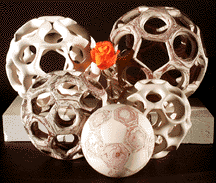
After twenty-five years as a high school chemistry and physics teacher and five years teaching mathematics, I returned to my first love -- art. Launching my post retirement hours into a full-time exploration in the plastic arts, I chose the most delicate and difficult of all media -- porcelain.
Although for many years I was not aware of it, I gradually found that my Arabic heritage has always informed my art, and imbues my aesthetic with a classical, traditional approach. Symmetry and classic lines display an exceptional grace and perfection, so I chose to focus on sculpting spherical porcelain vessels. Could I attempt to make the perfect spherical vessel -- as perfect as what can be found in the natural world -- the planets, a bubble, a drop of water in a gravitation free environment? This question and this challenge proved to be a compelling proving ground for my background in both art and science -- a place where I could combine the exactitude of measurement, the mathematics of the sphere and exercises in geometry with the unique aesthetics of embedded design.
My work brings together in three dimensions the same symmetrical elements that define the beautiful works of Islamic sacred art. Historically, Islamic artists mastered the application of mathematics to patterned tilings because their work could contain no graven images. These interlaced designs embody an unbroken rhythm, regularity and interwovenness that only such abstract forms can convey. I wanted my finished works -- vessels which introduced curvature to the embedded design, to bring a new dimension to the geometric art experience, one that was both natural and abstract at the same time. But unlike traditional Islamic design, and as an homage to the latter half of 20th century science, I also wanted to combine both chaos and order into a symmetrically unified "whole."
I am now embarking on my seventh year discovering and evolving this very different approach to ceramics. As I began to define the Porcelain Process in the early days, I drew from my experience as a scientist and injected rigor and documentation into the artistic process. I had to chart the evolution of my work so I could define a new way of sculpting this material. Using color-coded graphs and information logged into a journal, I began to chart the evolution of each porcelain artwork. These logs proved to be an excellent way to document the life cycle of each piece. They also served to record the technical innovations that I was beginning to discover about the process itself. The early days were filled with experimentation. I tried many different approaches as I tried to perfect the Porcelain Process. Since 1992, I have worked out most of the technical problems with the technique. Today's work -- with the most recent piece up to #834 -- is larger, more complex and intricate. Each final artwork now may require up to one full year to complete.
ABOUT THE OCTAHEDRAL PORCELAIN PROCESS
In the art of pottery-making, the standard approaches to forming and shaping vessels fall into the coil, the slab, the mold and the wheel methods. Although the Octahedral Porcelain Process uses a few elements of these methods, it is essentially an entirely new approach to vessel building, drawing more from the fine art of sculpture. This process also takes full advantage of the dense and fine properties of liquid porcelain which render it a material as strong as steel and as delicate as glass when fired to maturity.
The Octahedral Porcelain Process has eight stages (hence, the name "octa" meaning eight and "hedral" meaning faces). These stages are: conceptualization, fabrication, equilibridization, sphericalization, sculpting, lid-fitting, drying and firing. Throughout this process I also use a significant amount of unconventional tools that conform to and address the unique spherical qualities of each finished Porcelainia vessel. Along with standard tools, I adapted ordinary household utensils such as wine glass rims, mason jar lids and copper tubing to create new spherical tools. In some cases, I constructed spherical tools from scratch out of porcelain, wood and metal.
The Octahedral Porcelain Process is a sculptural method in which, after forming a solid sphere or block of clay from gradually evaporated porcelain slip and small clay pieces, each individual work goes through a series of slow transformations of form. A solid block is carefully truncated to a more symmetrical polyhedral shape whose angles are compressed into the smooth curves of a sphere whose interior is then carefully sculpted into a hollow vessel with a near perfectly fitted lid. Through each transformation of the piece as it gradually goes from soft to leather hard, it begins to show more and more elements of its final, symmetrical, embedded design.
As the slow evaporation of water and the gentle rotations of the artist's hands and tools work the vessel into its final near-perfect spherical shape, time itself acts as a potter's wheel which smooths and rounds out the final appearance of each finished piece. The balanced distribution of moisture during evaporation helps the clay to achieve equilibrium at every stage. Water, at each stage, is the lifeforce of the clay. Thus, carefully monitored evaporation became the most essential transforming factor in the Octahedral Porcelain Process and the one that gave me the ability to properly work the clay during its eight specific stages.
GEOMETRY AND CARBON
Although all of my porcelain works draw from geometry, the one series where I could explore it fully was the Geometrica Style. Of the eight different Porcelainia "styles" I have developed, the Geometrica Style is also the one that integrates the elements of chaos and order into a perfect symmetrical unity that alludes to nature's design on a micro scale. Spherical shapes always embody fivefold symmetry, the same symmetry as you see in the 20 sided icosahedron, one of the five Platonic Solids that have been known for well over 2500 years. As I defined the Geometrica style I took a dramatic departure from solid vessels and began to create open geometric latticeworks.
These open lattice artworks were inspired by my explorations into carbon chemistry. They also stemmed from my appreciation for the work of R. Buckminster Fuller, who explored the energetic geometry of the sphere in his "synergetic geometry" and was best known as the inventor of the geodesic dome. In 1995 when I was spending time volunteering in Buckminster Fuller's archive, the newest form of carbon, buckminsterfullerene was becoming internationally recognized as one of most important new discoveries in chemistry. I was compelled to find a way to use the chemical processes of the Porcelain process to create artworks that embodied the unique symmetry of this 60 atom molecule of carbon. I wanted the newest work to represent the "perfect" symmetry of hexapent cage structure (a truncated icosahedron).
In 1985 chemists Richard Smalley and Harold Kroto and Robert Curl discovered the existence of a third form of carbon. Unlike the two other forms of carbon, diamond and graphite, this amazing 60-atom cage molecule was shaped like a soccer ball. Both Kroto and Smalley felt it most appropriate to name it, "buckminsterfullerene" for its striking resemblance to a geodesic dome. A new family of these molecules have since been found called "fullerenes." (Note: Diamond is a molecular network crystal with each carbon bonded to four others in a tetrahedral configuration. Graphite is formed in flat sheets with each carbon bonded to three others in a hexagonal configuration.)
As I began to work on this new series, I was thrilled to learn in early October, 1996 that Sir Kroto, Dr. Smalley and Dr. Curl were awarded the Nobel Prize in Chemistry for founding this important new branch of chemistry. So my goal for this series was to turn it into a commemoration and a gift. In the following year I was able to present one of these "buckyball" Porcelainia pieces to each scientist who contributed to this great discovery and to those who have contributed to the better understanding of the geometry which forms a basis for geodesic domes.
One of the most exciting chapters in the history of the discovery of buckminsterfullerene came when Richard Smalley and Harold Kroto were trying to figure out the "shape" of this extraordinary molecule. What was the geometric configuration of 60 atoms of carbon that would allow it to become a strong, hollow, but flexible shape? Smalley talks about staying up late one evening, pasting hexagons together - a shape that characterizes the latticework structure of carbon in its graphite form, finally realizing that what allowed the hexagons to curl into three dimensions was when the hexes formed pentagonal cavities. Both Smalley and Kroto also saw that Fuller's geodesic domes, latticeworks of hexagons and triangles also introduced pentagons. During the fabrication of my porcelain buckyballs, I basically use the same process that the scientists used to construct a spherical "lattice with sixty joints -- and the discovery of the unique symmetry of this geometry, the union of 20 hexagons which form 12 pentagons as they come together as a sphere, becomes part of the artistic process linking geometry and chemistry with art.
FABRICATING CARBON 60 IN PORCELAIN
FORMING BUCKMINSTERFULLERENE IN THE CARBON 60 STYLE
During the Conceptualization Stage of the new Carbon 60 Style required materials of appropriate size are prepared: a solid white porcelain sphere and the pieces to be attached - 20 hexagons and 12 pentagons. An additional 60 pieces may be prepared to fill the spaces produced where two hexagons and a pentagon meet (This is where the 60 carbon atoms are located.) During the Fabrication Stage, the edge of each piece is coated with dark red oxide slip before being attached to the sphere. Once attached, all the spaces between the pieces are filled with thick white slip. During the Equilibridization Stage, the completed work is enclosed in an air tight system while water begins to distribute itself evenly and the piece becomes uniformly dense. During the Sphericalization Stage, the firm yet plastic piece is made spherical using special tools. To begin the Sculpting Stage, the lid section is cut away from the sphere. The interiors of the two pieces formed are carved out and the lid shaped. During the Lid Fitting Stage, the preformed lid is fitted by gently rotating it in its opening and removing clay from the smudged high points. In the last two stages, Drying and Firing, the work proceeds in the traditional fashion. (THIS WILL HAVE six pictures)
FORMING BUCKMINSTERFULLERENE IN THE GEOMETRICA STYLE
A template of 20 plastic hexagons are fitted with masking tape on the surface of a white porcelain solid sphere of appropriate size. Porcelain is removed from the 12 pentagons openings formed, leaving about one inch below each of the hexagons. During this time the porcelain is smoothed and compressed as water is lost. Once firm enough, the template is removed. A hole is formed at the center of each hexagon. The open lattice form can now be "fine tuned" to the artist's liking. (THIS WILL HAVE two pictures)
BOBBY I THINK YOU STILL NEED THIS TEXT BELOW:
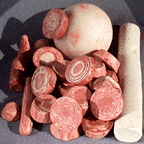 | Twenty buttons (left) with diameters of 3.8 cm and height of 1.5 cm are reshaped with diameters is 3.3 cm (inner) and 4.3 cm (outer). This will allow them to correctly fit the surface of the white sphere with circumference of 29 cm. They will then acquire the correct configuration of the hexapent, i.e., five hexagons around one pentagon (right). | 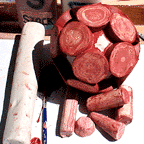 |
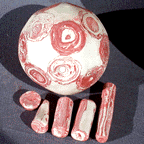 | 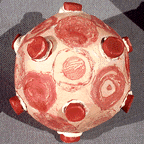 | 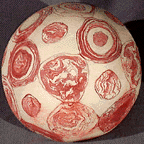 |
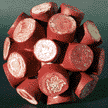 | 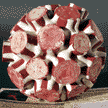 | |
| The 12 negative pentagon star-like spaces are then filled with white porcelain (far left). To complete the embedding of material, a small cone-shaped scrap is embedded in the center of each of the 12 pentagons (center). On the following day, the protruding cone pieces are cut away and the surface is smoothed and compressed. The sphere is finally water sanded (right). | ||
THE DELICATE BALANCE OF CHAOS AND ORDER
During the process of combining geometry, science, and art, I have discovered how each can contribute to the other, how each is dependent on the other, and how the line between each is difficult to identify. My experience with ceramics has reinforced the belief that mathematics and science can give beauty and order to Nature's chaos. With Nature as guide, themes of simplicity and universality are developed. Imagination produces patterns of ordered chaos. There is no compromise in the integrity of the work.
As a sculptor of porcelain using neriage as a technique, the challenge for me is to express as accurately as possible an idea whose perfection exists only in the mind. Each work reflects those attributes of the ideal; yet, it has its own unique personality. I continue to search for and invent ways to improve on the process; yet, at any given time the evolving work represents the best that it can be. With intensity tempered by experience, the mind is focused at the physical point in space/time where artist and work meet. Here the mind's eye gives direction to the energy shaping form from matter. Each work is the fruit of this ongoing interactive process, and the measure of its success is the extent to which it communicates the ideal.
Ceramics does not occur in a vacuum. Each completed porcelain vessel embodies the successes and failures of all the previous work. Throughout the process, each piece exhibits the interconnectedness of existence, change, rebirth, and growth. Each piece embodies reality as a shadow of the idea, the last event as the consequence of all that came before, and is a statement summarizing ones total life experience. Each piece approaches but never reaches a unique perfection defined by the artist. Because there are no absolutes, each work is an expression unique unto itself and is a step in the never ending journey toward the elusive ideal.